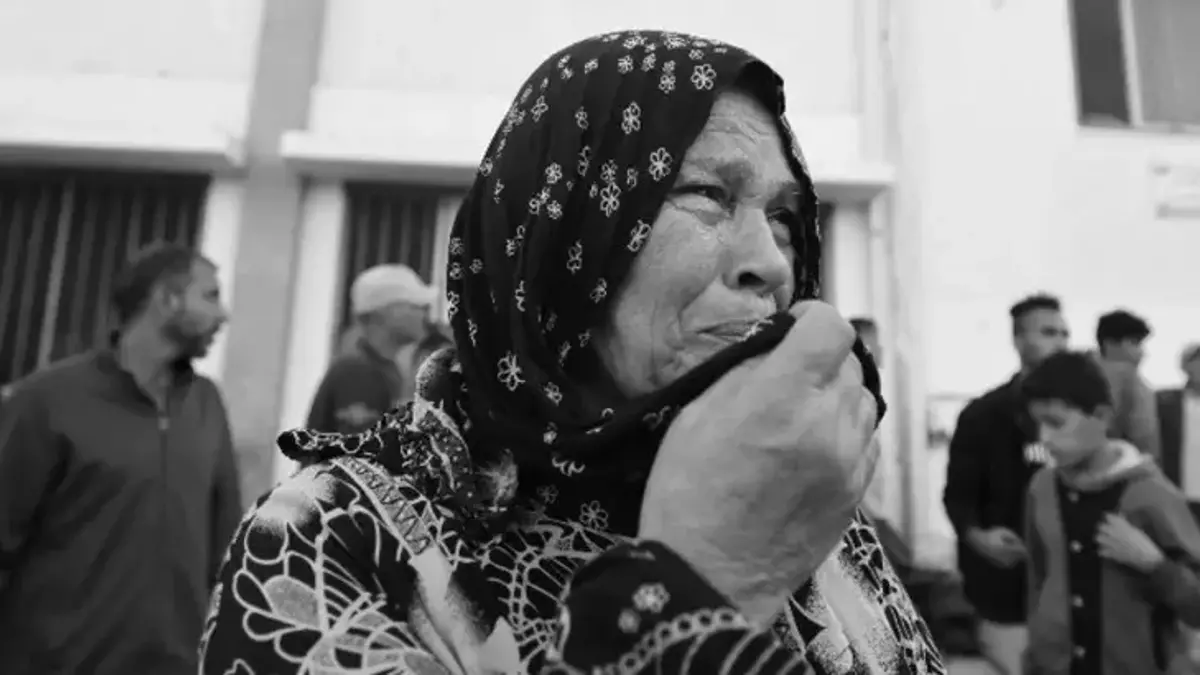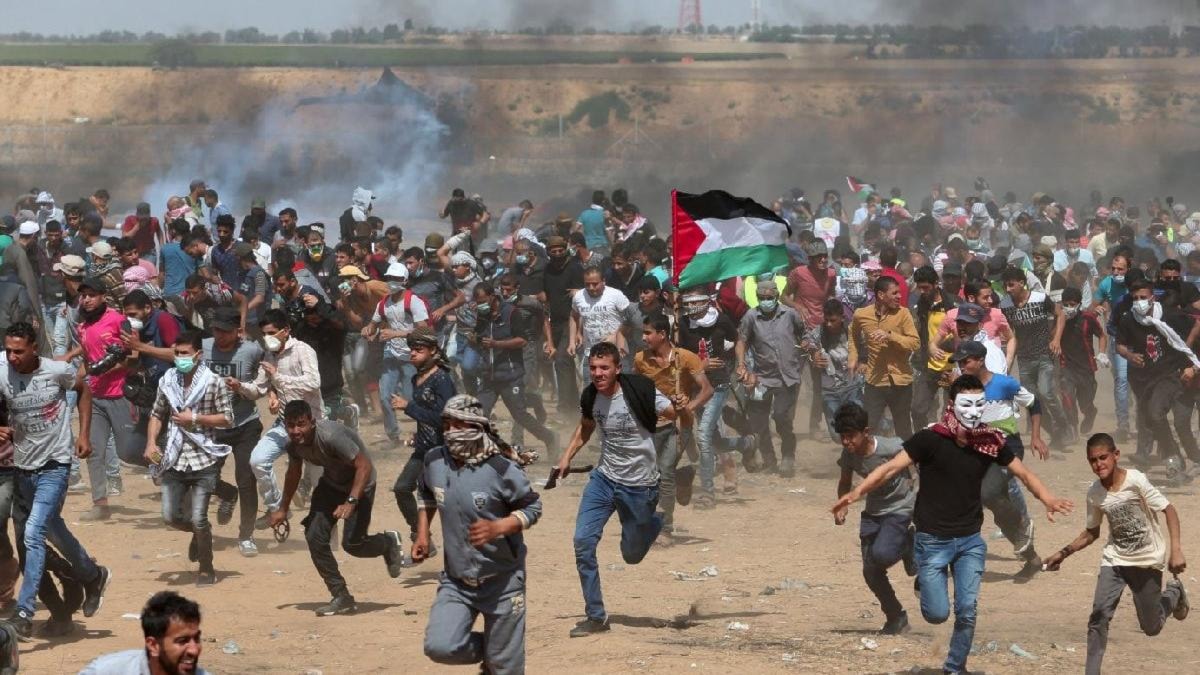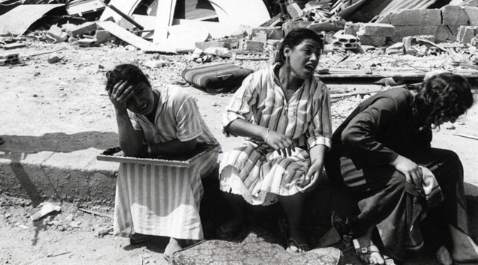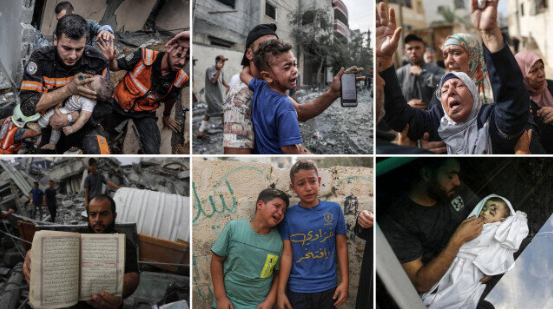
75 years of oppression, tears and resistance in Palestine
75 years of oppression, tears and resistance in Palestine
Founded on May 14, 1948, under the auspices of the West, Israel has been bringing blood and oppression to the occupied Palestinian territories for 75 years. The Palestinians mark this day as the Day of the Nakba "catastrophe". Shortly before that, on April 9, Israeli terrorists stormed the village of Deir Yassin, killing 254 Palestinians. According to the UN, 726,000 Palestinians have been forced to migrate due to the ongoing massacres. Since then, there have been massacres, forced migrations and an "intifada".
On April 25, 1920, the League of Nations decided to authorize Great Britain to manage the mandate of the region. In 1917, British Foreign Secretary Arthur Balfour promised to create a homeland for the Jewish people in Palestine. This promise was contained in a letter sent to Lord Rothschild, one of the leaders of the Zionists. This letter is called the Balfour Declaration.
NAKBA AND DEIR YASSIN MASSACRE
Unable to solve the problem, the British administration left the country in 1948. Jewish leaders proclaimed the creation of the State of Israel. The decision came into force on May 15, when the last British troops left the area. The State of Israel was the first Jewish state established in 2000 years. Palestinians celebrate May 15 as "Al-Nakba", the day of the "Catastrophe". On April 9, Irgun and Lehi militants killed 254 Palestinians in the village of Deir Yassin near Jerusalem. According to the UN, 726,000 Palestinians have been forced to migrate. During this period, Palestinian settlements consisting of 675 villages and towns were liquidated.
6-DAY WAR
Growing tensions between the occupying Power Israel and its Arab neighbors led to the Six-Day War, which began on June 5, 1967. In these six days, the face of the Middle East conflict has changed. Israel occupied the Gaza Strip and the Sinai Peninsula from Egypt and the Golan Heights from Syria. Jordan has also withdrawn its troops from the West Bank and East Jerusalem. The UN Security Council adopted resolution 242. The resolution rejected the acquisition of territories by war and demanded that Israel withdraw from the areas it had captured during the recent fighting. According to the UN, another 500,000 Palestinians have become refugees in this war. About 650 thousand Jewish occupiers were settled in the newly created settlements.
1973 THE YOM KIPPUR WAR
Yom Kippur, the "Day of Atonement", is the most important religious holiday of the Jewish people. Having failed to regain the territories lost in the 1967 war by diplomatic means, Egypt and Syria launched an offensive against Israel during the Yom Kippur holiday in 1973. Initially, Egypt and Syria advanced on the Sinai Peninsula and the Golan Heights. After three weeks of fighting, the situation changed after the US supported Israel. In some places, Israel eventually moved beyond the 1967 ceasefire line. Although later these lands were abandoned. In Egypt, Israeli troops also seized territory and moved to the west bank of the Suez Canal.
PEACE TREATY WITH EGYPT 1977
When Egyptian President Anwar Sadat flew to Israel on November 19, 1977 and delivered a speech in the Knesset, the parliament, the world was stunned. Sadat was the first Arab leader to recognize Israel. Egypt and Israel signed the Camp David Accords in 1978. The text referred to peace in the Middle East, including granting limited autonomy to the Palestinians. The Sinai Peninsula was returned to Egypt. The Arab States boycotted Egypt for negotiating with Israel on its own. Anwar Sadat was killed in 1981 by units of his own army.
SABRA AND SHATILA MASSACRE
The invasion of Lebanon began after the assassination attempt by Abu Nidal's organization on the Israeli ambassador in London. When the PLO militia left the country in accordance with the ceasefire agreement, the Palestinian refugee camps were left defenseless. As Israeli troops massed around Beirut on September 14, Bashir Gemayel, the leader of the Christian Phalanx militia, was killed in a bomb attack at his headquarters in the capital. The next day, the occupying Israeli forces entered West Beirut. From September 16 to 18, Falangists in alliance with Israel killed hundreds of Palestinians in the Sabra and Shatila camps.
THE FIRST INTIFADA
The intifada, or mass uprising against the Israeli occupation, began in the Gaza Strip and soon spread to the West Bank. The uprising began when a car belonging to the occupation authorities hit four Palestinians. The protests took the form of civil disobedience. General strikes were organized. Israeli forces responded to Palestinians throwing stones at heavily armed soldiers; many Palestinian civilians were killed. During the protests that lasted until 1993, 1,087 Palestinian civilians were killed.
MADRID SUMMIT 1991
The US administration has focused on the search for peace in the Middle East. Repeated visits by US Secretary of State James Baker paved the way for the convening of an international summit in Madrid. Syria agreed to join; he hoped to enter into negotiations that would allow the return of the Golan Heights. Jordan also accepted the invitation. However, conservative Israeli Prime Minister Yitzhak Shamir did not want to deal directly with the PLO, so a Palestinian-Jordanian delegation consisting of prominent Palestinian figures was formed.
THE OSLO PEACE PROCESS
In June 1992, the coming to power in Israel of the left wing, the Avoda Party, marked the beginning of a very strong peace process. Prime Minister Yitzhak Rabin, who was portrayed as a hardliner, as well as Shimon Peres and Yossi Beilin, who were portrayed as "pigeons", sided with Israel. When it became clear that the bilateral negotiations in Washington would not bring any results, on January 20, 1993, the secret Oslo alley was opened. The Palestinians agreed to recognize the State of Israel in exchange for a phased withdrawal of troops from the occupied territories. As a result of the negotiations, a Declaration of Principles was adopted. When this document was signed in Washington, 400 million people watched the historic handshake between Arafat and Rabin live on air. In 1994, the Palestinian Authority was officially established.
THE SECOND OSLO AND THE MURDER OF THE LORD
The Palestinian Authority experienced difficulties in its first year in the Gaza Strip. Dozens of Israelis have been killed in bombings carried out by Palestinian militants.Israel is blocking entry and exit from the territory of the autonomous Administration; militants have been killed. The construction of new settlements did not stop either. On September 24, the agreement, known as the Second Oslo, was signed at separate ceremonies in Taba (Egypt) and in Washington. Israeli religious people were dissatisfied with the surrender of the "Jewish land". Prime Minister Yitzhak Rabin, the target of a campaign filled with anger and provocations, was assassinated on November 4, 1995 by a Jew belonging to an extremist religious movement whose representatives are now in the Israeli Government.
THE SECOND INTIFADA
The leader of Netanyahu's Likud opposition party Ariel Sharon, a right-wing politician for many years, visited the complex where the Al-Aqsa Mosque is located. I was told that this is a very provocative step. Palestinians have started demonstrations to protest the visit. And the demonstrations escalated into the so-called Al-Aqsa intifada. During the second intifada, which lasted 5 years, 4,412 Palestinians were killed and 48,322 injured. At the same time, 1,069 Israelis were killed and 4,500 wounded. The uprising, which lasted 5 years, paved the way for the rise of Hamas. Mohammed Durra, who was martyred in his father's arms as a result of the fire set by the occupation authorities, became a symbol of the 2nd intifada.
OPEN-AIR PRISON IN GAZA
The Gaza Strip, which was suppressed by the illegal blockade of the Tel Aviv administration after Hamas won the Palestinian elections in 2006, has been the target of 5 major Israeli attacks over the past 17 years. Since 2005, it has been under land, sea and air blockade. The Gaza Strip, which has been called the "largest open prison" in the world, borders Israel to the north and east, Egypt to the south and the Mediterranean Sea to the east. More than 2 million people live in this region with a length of 41 kilometers and a width of 10 kilometers. The Gaza Strip has been trying to resist both the Israeli blockade and attacks for many years. Currently, with the exception of the Rafah border crossing with Egypt in the south, most of the land access to the Gaza Strip is completely in the hands of Israel, including control over the airspace. In the sea, it controls areas other than a small hole.
RAIDS ON THE WEST BANK AND AL-AQSA MOSQUE
Likud leader Benjamin Netanyahu, who was re-elected prime minister in December 2022, formed an "extreme right" government, which is called the most racist government in the country's history. Itamar Ben-Gvir, the leader of the Otzma Yehudit (Jewish Power) party, one of the coalition parties, organized marches with slogans such as "Death to the Arabs." Ben-Gwir's raids on the Al-Aqsa Mosque under police protection led to an escalation of tension. The far-right coalition formed under the leadership of Benjamin Netanyahu has decided to pursue a tough policy towards the Palestinians. In 2023, Israeli forces conducted large-scale raids in the West Bank, and over 200 people were killed during these raids in 9 months. More than 900 people were arrested.
OPERATION AL-AQSA
In October, Hamas launched Operation Flood in Al-Aqsa against Israeli repression. In a short period of time, Hamas troops captured dozens of districts.
TERROR OF THE SETTLERS AT THE TOP
Illegal settlement activity, which Israel promised to stop but used as an occupation base, is at its highest level since 2012. According to Peace Now, the number of settlers in the West Bank has reached 506,000, and in East Jerusalem – 230,000. Israel is trying to secure its occupation plans by settling Jewish settlers on Palestinian land. The settlers, armed with the occupation authorities, confiscate the lands of the Palestinians and plunder their property under the protection of the Israeli army. Palestinians who cannot accept the situation are either arrested or forced to emigrate. The Israeli government approved 7,325 housing units in 2012, 5,749 in 2013, 2,472 in 2014, 1,245 in 2015, 2,292 in 2016 and 6,742 in 2017, 5,618 in 2018, 8,457 in 2019, 12,159 in 2020, 3,645 in 2021 and 4,427 in 2022. Finally, the appointment of two radical candidates for the most important posts in the Israeli Government, representing fascist and racist settler terrorists, has led to an increase in tension and violence in the region.







